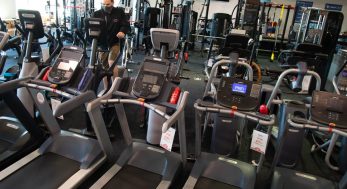Above a certain tax bracket, there’s no shortage of financial advisors helping people to invest, save and budget their money. However, there is a notable dearth of financial planning options for the average consumer. Though apps for budgeting and saving provide accessible options for millennials and Gen-Z consumers, they lack the accountability and human touch that a real-life financial advisor can bring to understanding each person’s specific situation. Too often, customers are sold a product, rather than provided a real, helpful service.
Shannon McLay, former financial advisor and founder of the New York-based Financial Gym, is on a mission to orient the financial services industry around actual service, delivering value to her members via high-touch experience and community. Inspired by the gym itself, the Financial Gym encourages its members to commit to lifestyle changes around financial health using a model that prioritizes community, acceptance and personalization.
PSFK spoke to Shannon about her journey from Wall Street to startup, and why it means so much to her to provide her customers—especially women—with the education and support to reach fuller financial health.

PSFK: Tell us about the inspiration for why you started The Financial Gym. What gap or white space did you see that wasn’t being filled?
Shannon: Originally, I saw a gap in financial advisory. When I was looking for a financial advisor, I didn’t see enough women. It felt unfair to me for women or anybody of diversity to not be able to find female assistance if they wanted it. So I became a financial advisor.
My initial intent was to help more women become financial advisers. That was my mission at Merrill Lynch. In working with clients, you had to have $250,000 in assets to work with me. I had always been around money, so I didn’t think anything of it. When I became a financial adviser, one of my first meetings was with a woman who wanted to hire a financial adviser said, “I have $250,000 in student‑loan debt. I make $50,000 a year. I feel unlovable because of all this debt.”
It was my first eye‑opening experience of somebody else’s financial journey that was completely different from my own. I couldn’t do anything for her through the Merrill Lynch area, but I wanted to help her.
I made up a financial plan just in Word, telling her what to do. I kept getting more of those pro bono clients—I called them that, but they weren’t looking for a free plan. They wanted to pay me, but I didn’t have a way to take their money because they didn’t have the assets. This was my a-ha moment that people needed more than a product.
The financial services industry is inherently flawed. We need services. We need to be able to give people the service they want to pay for, and look at them holistically and not look at them and say, ‘What product can I sell them?’
When that woman said I saved her life, it was like a lightning bolt. Everything in the universe came together at that point, and I saw a financial gym. You pay a monthly membership fee. Financial advisers aren’t these guys in suits, they’re in jeans and t‑shirts. It’s like H&R Block, but it’s cool. You know you can walk in and get help.
Along those lines, where do you see the Financial Gym fitting into the average consumer’s life? The way you bill it is as a subscription model like Netflix or a gym membership.
We view it like a gym—like a lifestyle choice. Financial wellness is your lifestyle choice just like people who belong to Planet Fitness, Equinox or any gym. They’re choosing physical fitness as a lifestyle option. No matter how much they go there, they’re still saying, “This is important to me.”
We want to give people the ability to say, “Financial wellness is important to me,” and then make it a lifestyle choice.
Can you explain how membership works?
Our process starts with a warm‑up call. Inherently, it’s a leap of faith to even get people to sign up for a phone call, so we are working on getting it to self‑selection, where customers can book themselves with trainers.
The warm‑up call’s really important, actually, because it’s a way for us to get to know the customer. What do they feel like their problem area is, their financial weaknesses are? Do they need help with budgeting? Do they just not know where their money is going? Do they want investing help? Do they have a business? Are they married, kids?
Also, what are the things that are important to them? What are maybe some of their triggers? We try to get an idea from the customer regarding the type of financial trainer that would be a good fit. Do they need somebody who’s warm and fuzzy, a cheerleader? Do they need Jillian Michaels?
After the warm‑up call, they get paired with a trainer. They get scheduled for their first session, which we call the “financially naked” session. These are things some people have never told their significant other, maybe never told anybody before. We know it’s a sensitive day for most people.
It’s like the community‑building experience of “I made it through. I did this. I shared everything with this person.” It’s like you’re stepping on the scale, really. We don’t care what you weigh. We care about where you want to go. We care about what you want for your life. We don’t care about right now, because we know everything’s fixable. That’s all we’re doing in the first session. That’s the first session.
The second one is they get a financial plan. We give a financial value to all the goals they’ve set. Then we ultimately give the customer the budget they need to keep.
We break the plan down to 30‑, 60‑, 90‑day goals. Then we meet every 90 days after that. After they get their plan, they have access to their trainer whenever for check-in meetings.

How does the membership work structurally in terms of how much it costs?
Our core client’s paying $85 a month. Couples pay a little bit more. People who have businesses and more complicated finances are usually paying around $200‑$250 a month. Then we have a scholarship program that’s $50 a month. That’s usually college students. Trainers have the ability to make the final assessment on what we charge clients.
They value the accountability the service is going to force them into when they see that it hit their bank account or their credit card.
We also know financial health takes some time for people. In the first three months, our average client is going to save $2,500 or increase their net worth $2,500. They’re going to increase their credit score by 50 points and negotiate $5,000 more in income. The average person’s going to do it, but sometimes some people take a little bit longer to figure it out and we know that.
We want customers to at least try it out for six months. If customers are not better off in the six months having worked with us, then we’re happy to pay it back. But we haven’t had to do that yet.
Why did you choose a membership-based service as opposed to a la carte?
Eventually we’ll have a la carte. We do have some one‑off people who ask for that, but it is important for us to build a community. Customers ask sometimes, “What is the monthly membership fee for?” Honestly, it doesn’t necessarily always pay for something every month, but it pays for that access to a person.
How do you make consumers comfortable? Why is that important to you?
Money is the ultimate taboo topic. I didn’t realize how taboo it was until I started building this business. When I started this, and started to ask all of the holistic questions of finances, I realized how uncomfortable people were. Our financial numbers do not define us. It’s just a number in time and it doesn’t matter. It only matters what you want to do.
Some people do come in really stressed out. I’d say fear and shame are the two words we hear here, which are really charged emotions. Just like fear and shame are mostly in our head, it’s mostly in people’s heads.
In the last six years of building this, we’ve had clients start with negative dollars in the bank. We’ve had clients start with seven million. We’ve had clients making zero; we’ve had clients making $800,000, $900,000. $700,000 of debt, $400,000 student loan debt, $80,000 credit card debt—we’ve literally seen it all, so we don’t care.
Do you have a target consumer? Is it women specifically or is it just inherently female‑friendly because of the team behind it?
95% of those who calls us are women, and I know it’s not because we only have women on our website. Usually women are more open to looking for a third party in their financial situation. Guys can be more DIY, or want a traditional advisor. They’re not really looking for us anyway, so I’m not overly concerned with attracting them.
While that has certainly informed how we are doing our business, still 65% of our Gym population is women, 35% is men. We have men in here, loving it and being very successful. Our core demographic is working women between the ages of 26 and 35.
Finally, does the Financial Gym have plans for future expansion into other cities?
Now, probably 40% of our Gym population is remote. We work with clients in 48 states and the District of Columbia. Wyoming and North Dakota—we’re looking out for people there. Those are our last two missing states.
We have our current location here in New York. We do plan to have Gyms across the country. We hope to open up five Gyms in the next year‑and‑a‑half or so.

Pictured: Shannon McLay.
For examples of innovative services like the Financial Gym, see PSFK’s reports and newsletters.

